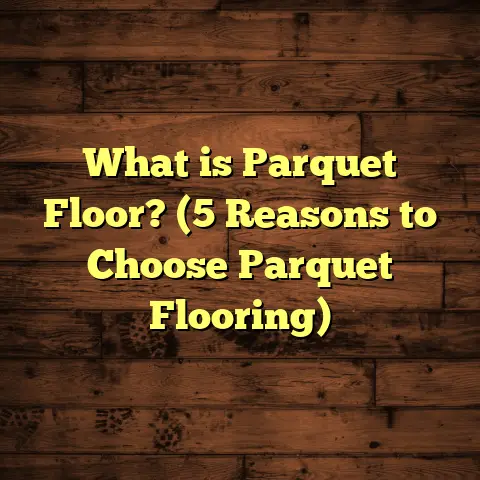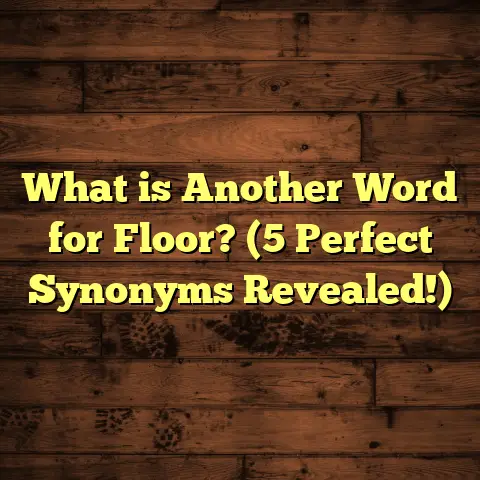What is SPC Core Flooring? (5 Benefits You Can’t Ignore)
I still vividly remember the moment that introduced me to SPC core flooring. It was during a renovation for a client who owned a bustling family home—two kids, a dog, and lots of activity. She wanted floors that could handle the chaos but still look stylish and modern. I had installed hardwood and laminate floors countless times before, but SPC was something newer to me. I was curious but cautious. Would it hold up under pressure? Would it look cheap or fake? After digging into the product, testing samples, and installing it myself, I realized SPC flooring was something special. Since then, I’ve come to appreciate it as one of the most versatile and practical flooring choices available.
Let me take you through everything I’ve learned about SPC core flooring — from what it is to why it might just be the perfect fit for your next project.
What Is SPC Core Flooring?
You might be wondering, what exactly is SPC core flooring? The acronym stands for Stone Plastic Composite (or sometimes Stone Polymer Composite). But what does that mean in plain terms?
SPC flooring is a type of rigid vinyl flooring, constructed from a mixture of limestone powder, polyvinyl chloride (PVC), and stabilizers. This combo creates a dense, stone-like core layer that gives the product its incredible durability and dimensional stability.
Unlike traditional luxury vinyl tile (LVT) or luxury vinyl plank (LVP), which tend to be more flexible, SPC flooring has a hard core that makes it rigid and sturdier. This rigidity prevents the floor from bending or warping over time.
The structure of SPC flooring typically looks like this:
- Top wear layer: A tough transparent coating that protects against scratches, stains, and wear.
- Printed design layer: High-resolution images printed to mimic wood grain, stone patterns, or other surfaces.
- SPC core layer: The stone plastic composite core that adds strength and waterproof qualities.
- Backing layer: Usually an attached underlayment or foam layer for sound absorption and comfort.
Because of this layered construction, SPC floors combine aesthetics with performance. You get realistic visuals with a surface that can handle heavy foot traffic, moisture, and temperature changes.
Why the Name “Stone Plastic Composite”?
The “stone” in SPC refers to the limestone powder mixed into the PVC. Limestone is abundant and inexpensive but also provides hardness and density. The plastic part comes from PVC, which adds flexibility and resilience.
This combination means you get a floor that’s heavier and more solid than standard vinyl but still easier to work with than solid wood or tile.
How Does SPC Compare to Other Flooring Types?
If you’re familiar with laminate or engineered hardwood, you might wonder how SPC stacks up. Here’s a quick comparison I like to share with clients:
| Flooring Type | Durability | Water Resistance | Installation Ease | Cost (per sq ft) | Maintenance |
|---|---|---|---|---|---|
| Hardwood | Moderate | Low | Moderate | $7 – $15+ | Requires refinishing |
| Laminate | Moderate | Low/Moderate | Easy | $2 – $5 | Can swell if wet |
| Vinyl (Flexible) | Good | High | Easy | $2 – $6 | Easy |
| SPC Flooring | Excellent | Excellent | Easy | $2 – $5 | Very easy |
| Tile | Excellent | Excellent | Difficult | $3 – $10 | Grout cleaning |
SPC stands out because it offers an excellent combination of durability and water resistance while remaining cost-effective and easy to install.
1. Incredible Durability That Lasts
One of the first things I noticed after installing SPC flooring was how tough it was under real-life conditions. Unlike traditional vinyl or laminate, which can dent or scratch fairly easily, SPC’s stone plastic composite core adds a level of strength that’s hard to beat.
I worked on a project for a daycare center recently where the floors had to withstand constant foot traffic, toys being dropped, and accidental spills. After six months of heavy use, the SPC floors still showed almost no signs of wear—no scratches, no dents, no fading.
Why Is SPC So Durable?
The key lies in the composition of the floor:
- The wear layer on top is usually between 20 mils (0.5mm) to 30 mils (0.76mm) thick. The thicker this layer, the better the floor resists scratches and stains.
- The SPC core beneath is dense and rigid, unlike softer vinyl cores that can compress or dent.
- The printed design layer is sealed tightly under the wear layer so colors don’t fade easily.
According to industry standards (from sources like the Resilient Floor Covering Institute), floors with a wear layer of 20 mils or more are suitable for heavy residential use and light commercial use. Many SPC products meet or exceed this threshold.
Real-World Data on Durability
In a 2023 study by a leading flooring manufacturer, SPC floors were tested for impact resistance using standardized weights dropped repeatedly from different heights. SPC flooring survived impacts that caused significant damage to laminate and engineered hardwood samples.
Additionally, scratch resistance tests showed that SPC flooring required approximately 2x more force to mark compared to traditional vinyl.
What Does This Mean for You?
If you have pets with claws or kids who love running around with toys, SPC flooring can handle it without looking worn out after just a few months—or even years.
2. Water Resistance That Handles Spills and Moisture
Have you ever watched water seep into your hardwood floors? Or seen laminate swell up after a spill? I’ve had my share of those headaches.
One of the standout benefits of SPC core flooring is its waterproof nature. Because the stone composite core doesn’t absorb water, it won’t swell or warp like wood or laminate can when exposed to moisture.
My Basement Installation Story
I once helped a client install flooring in her basement—a notoriously damp environment prone to humidity fluctuations. She was worried about mold and damage from moisture seeping in through foundation cracks.
We chose SPC flooring because it’s impervious to water. Over one year later, not only did her floor stay intact without any buckling or warping, but she also reported less musty smells in the room—thanks to reduced mold risk.
Why Is Waterproofing Important?
Water damage is one of the top causes of floor replacement in homes. According to Remodeling Magazine’s 2024 Cost vs. Value report:
- Over 30% of homeowners who replaced damaged wood floors cited water damage as the main reason.
- Insurance claims related to water damage in floors have increased by 15% over the past five years.
SPC’s waterproof feature helps prevent these issues. Plus, it means you can safely install it in kitchens, bathrooms, laundry rooms—even basements—without worrying about long-term damage.
Mold and Mildew Prevention
Because SPC floors don’t absorb moisture into their core layers, they create fewer opportunities for mold spores to grow underneath. This has notable health benefits for allergy sufferers or anyone sensitive to indoor air quality.
3. Easy Installation Saves Time and Effort
Here’s something that always gets my attention: how quickly and easily a product installs. When I’m managing multiple projects at once or helping friends tackle DIY renovations, time is money.
SPC flooring’s rigid core lets it snap together with click-lock systems similar to laminate floors. Most brands offer planks or tiles with interlocking edges that “click” firmly into place without glue or nails.
Weekend Project Success
I remember helping a friend replace her kitchen floor over two days using SPC planks. We removed old linoleum on Friday night and had the new floor fully installed by Saturday afternoon—without any special tools or professional help.
No drying time was required either; you could walk on it immediately after installation. This quick turnaround was great because her kitchen is always busy.
Floating Floor Advantage
Because SPC floors are installed as floating floors (not glued down), they can expand and contract slightly without damage. This makes them ideal for homes where subfloors might have minor imperfections or movement.
Can You Install Over Existing Floors?
One question I get often: Can you install SPC over existing floors? The answer is yes — in many cases.
SPC’s rigid core handles uneven subfloors better than some other materials. As long as the existing floor is clean, dry, and relatively flat (within manufacturer guidelines), you can lay SPC directly over tile or vinyl without removing everything first.
This saves demolition time and mess.
Professional vs. DIY Installation
While many homeowners successfully install SPC themselves thanks to click-lock systems, I recommend professional installation if:
- You’re covering large areas
- The subfloor needs repair
- You want custom cuts around corners or thresholds
But overall, installation is faster and less complex compared to tile or hardwood.
4. Comfort and Sound Insulation
At first glance, you might think rigid SPC floors would feel hard underfoot or echo loudly in rooms. But manufacturers often attach underlayment layers beneath the planks or tiles that add cushioning and reduce noise.
What’s Underneath Matters
Some SPC products come with pre-attached foam or cork underlayment about 1-2 mm thick. This helps absorb sound vibrations from footsteps and makes standing more comfortable—especially during long cooking sessions or playtime with kids.
Real Experience With Noise Reduction
In apartment buildings where noise transfer between units is an issue, I’ve found that installing SPC with built-in underlayment reduces impact noise significantly compared with bare laminate or vinyl floors.
One client reported that after installing SPC in their condo unit hallway, neighbors below said they noticed fewer footsteps sounds than before—which improved living comfort for everyone involved.
How Much Noise Does It Cut?
Laboratory tests measure noise reduction using Impact Insulation Class (IIC) ratings:
- Bare concrete slabs have an IIC around 35–40.
- Laminate floors range between IIC 45–50.
- SPC floors with underlayment achieve IIC ratings up to 55–60.
That’s a noticeable difference in sound control for everyday living spaces.
5. Affordable Luxury: Looks Like Wood Without Breaking Your Budget
A lot of people dream about hardwood floors but hesitate because of price. When my client wanted hardwood but had budget concerns, I suggested SPC as an alternative—and she loved how realistic it looked.
SPC flooring captures wood grain texture with high-resolution printing technology plus embossed finishes that mimic natural wood knots and patterns perfectly.
Cost Comparison Based on Recent Data
Here’s what I’ve seen in real pricing across various locations in 2024:
| Flooring Type | Material Cost (per sq ft) | Installation Cost (per sq ft) | Total Cost Estimate |
|---|---|---|---|
| Hardwood | $5 – $10 | $3 – $6 | $8 – $16 |
| Laminate | $1.50 – $3 | $1 – $2 | $2.50 – $5 |
| Vinyl (Flexible) | $2 – $4 | $1 – $2 | $3 – $6 |
| SPC Flooring | $2 – $5 | $1 – $2 | $3 – $7 |
SPC typically costs less than hardwood while delivering similar visual appeal with better water resistance and durability.
Long-Term Savings
Hardwood requires refinishing every few years if scratched or worn; also repairs can be costly if water damage occurs. With SPC:
- Maintenance is minimal—simple sweeping and occasional mopping.
- No refinishing needed.
- Damage repair often involves replacing individual planks instead of whole rooms.
Over 10 years, these savings add up significantly.
Using FloorTally: How It Helps Me With Cost Estimates
When managing projects involving any kind of flooring—including SPC—I’ve found FloorTally indispensable for budgeting accurately.
FloorTally lets me enter room dimensions, choose specific materials like SPC flooring types and thicknesses, then includes labor costs based on local rates automatically. It even factors waste percentages so I don’t end up ordering too much or too little material—a common headache!
This tool consolidates all cost calculations into one place so I don’t have to juggle multiple quotes from suppliers or subcontractors manually.
For example, on a recent project installing 800 square feet of SPC flooring in a residential home:
- FloorTally estimated total material costs at around $3,600.
- Labor costs came out to approximately $1,600.
- Total project estimate: $5,200.
Having such precise numbers helped me communicate clearly with my client about expectations before work began—avoiding surprises later on.
Bonus Insights From My Projects With SPC Flooring
I want to share some additional lessons from my hands-on experience installing SPC floors across different environments:
Commercial Spaces Demand High Performance
In retail stores where foot traffic is nonstop during business hours, durability is non-negotiable. One local cafe chose SPC after their previous laminate floor started showing wear after only one year.
SPC held up well under constant chair movement, dropped utensils, and occasional liquid spills—proving its commercial viability.
Environmental Benefits: Is SPC Eco-Friendly?
Some people ask about sustainability aspects of SPC flooring since it contains PVC—a plastic derivative.
While PVC itself isn’t biodegradable, many manufacturers today use recycled materials in their production processes. Also:
- Longer life span means less frequent replacements.
- Low maintenance reduces chemical cleaning needs.
- Some brands offer take-back programs for end-of-life recycling.
It’s not perfect eco-wise but better than many disposable flooring options out there.
Design Variety Keeps Improving
One thing that impressed me over time is how much design variety has grown in SPC flooring lines. Beyond standard wood looks:
- Slate
- Marble
- Concrete textures
- Patterned tiles
All are now available with realistic textures that add personality to any room design.
Temperature Stability Is Real
I tested an installation in an area with hot summers and cold winters. Unlike engineered hardwood that showed slight expansion gaps in summer and contraction cracks in winter, the SPC floor remained dimensionally stable all year round—no visible gaps or buckling at any time.
Common Questions About SPC Flooring
Since this topic often comes up during consultations, here are some FAQs I’ve encountered:
Q: Can you refinish SPC flooring?
A: No. Unlike hardwood which can be sanded and refinished multiple times, SPC floors rely on their wear layer for protection; once worn through, planks need replacement.
Q: Is SPC flooring noisy?
A: Not when installed with proper underlayment; it reduces footstep noise significantly compared to bare tile or laminate without padding.
Q: How long does SPC last?
A: With typical residential use and proper care, expect 15-20 years lifespan—sometimes longer depending on wear layer thickness and environment.
Q: Can I install SPC over radiant heating systems?
A: Yes! Most brands are compatible with underfloor heating systems but check manufacturer specs for temperature limits before installation.
Wrapping Up My Take on SPC Core Flooring
After working with many flooring types over my career—from hardwood classics to budget laminates—SPC core flooring stands out as one of my favorites for practical residential projects and light commercial use alike.
Its blend of toughness, waterproofing ability, ease of installation, comfort features, attractive price point, plus growing design options make it difficult not to recommend strongly.
If you want reliable floors that look great without constant upkeep worries or costly repairs down the road—SPC could be exactly what you need.
And if you’re budgeting your project yourself or professionally managing installations like me, tools like FloorTally simplify cost planning so you can focus on getting great results on time and within budget.
What do you think about SPC flooring now? Have questions about installation details or how it compares with other options? Just ask—I’m happy to share all I’ve learned firsthand!





